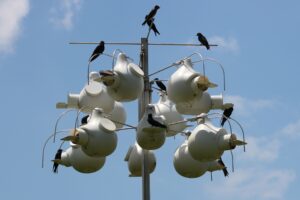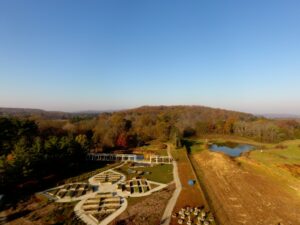
During both World Wars I and II, the U.S. government created a campaign for people to grow vegetables to support the war effort in what they called “Victory Gardens.” Parks, churchyards, backyards, pretty much any available land was encouraged to be turned into a vegetable garden. Poster slogans like “Our food is fighting!” and “Sow the seeds of victory!” supported a campaign that at its peak resulted in the astonishing numbers of over five million gardens in the US and food production exceeding $1.2 billion.
All those gardens are long gone now, save for a few, like the Fenway Victory Garden in Boston. And yet, generations later, we’re still battling terrible enemies, like wasteful irrigation practices, toxic runoff from chemically treated lawns, and the horrifying inequities in our food system that have led to the shocking fact that we have substantial groups of people who are simultaneously obese and undernourished. Maybe we need a new Victory Gardens movement to win the battle for healthy land and people.
 Visitors to Bernheim love our Edible Garden because it’s beautiful, fun to explore and full of things that smell and taste great. And of course, there are lots of cool creatures to marvel at, like butterflies, turtles and birds. But it’s also important to remember that the Edible Garden is a powerful and persuasive example of what an incredible impact we can have if we use even a small plot of land wisely. Garden Steward Cole Alexander has tracked its production levels over the years and the results are pretty amazing. In 2014, the first year from which we have tracked totals, the garden yielded 242 pounds of produce. In 2021 that had gone up to 3,266 pounds!
Visitors to Bernheim love our Edible Garden because it’s beautiful, fun to explore and full of things that smell and taste great. And of course, there are lots of cool creatures to marvel at, like butterflies, turtles and birds. But it’s also important to remember that the Edible Garden is a powerful and persuasive example of what an incredible impact we can have if we use even a small plot of land wisely. Garden Steward Cole Alexander has tracked its production levels over the years and the results are pretty amazing. In 2014, the first year from which we have tracked totals, the garden yielded 242 pounds of produce. In 2021 that had gone up to 3,266 pounds!
More than a ton and a half of berries, greens, garlic, squash, watermelon and lots more – in fact, there are about 45 different kinds of produce in the garden. That includes 359 pounds of tomatoes, 445 pounds of greens, and 255 pounds of zucchini. That’s why Isaac’s Café is able to serve our visitors such delicious, healthy, seasonal meals. 2021 was also the first year that Cole relied entirely on volunteer help to keep the garden thriving. Click here to find out about volunteer opportunities at Bernheim!
 The Edible Garden’s maintenance practices are all about working with nature. Climate change has brought warmer, wetter springs and falls, so we installed raised beds to prevent water from pooling and avoids root rot and fungal spread. Insect netting keeps insects like flea beetles and cabbage moths from ever getting to the plants while not trapping heat in which is important in the middle of summer. Frequent soil tests help Cole better understand what’s going on in each bed, which is really important in raised beds since they are each a unique colony of nutrients and microorganisms. “In the most basic sense, I adjust each bed to balance the N-P-K, pH, and mineral need and also incorporate no-till gardening practices, which allows the soil food web to stay completely intact. This practice allows tiny channels and pockets of space to stay within the soil to allow air flow and water dispersion. It also allows fungal networks to stay intact which can provide more nutrient uptake to plants and provides access to water deeper in the soil during dry periods.”
The Edible Garden’s maintenance practices are all about working with nature. Climate change has brought warmer, wetter springs and falls, so we installed raised beds to prevent water from pooling and avoids root rot and fungal spread. Insect netting keeps insects like flea beetles and cabbage moths from ever getting to the plants while not trapping heat in which is important in the middle of summer. Frequent soil tests help Cole better understand what’s going on in each bed, which is really important in raised beds since they are each a unique colony of nutrients and microorganisms. “In the most basic sense, I adjust each bed to balance the N-P-K, pH, and mineral need and also incorporate no-till gardening practices, which allows the soil food web to stay completely intact. This practice allows tiny channels and pockets of space to stay within the soil to allow air flow and water dispersion. It also allows fungal networks to stay intact which can provide more nutrient uptake to plants and provides access to water deeper in the soil during dry periods.”
Did we forget to mention that it’s also really beautiful? Its wheelchair-accessible raised stone beds lush with Mediterranean herbs wouldn’t look out of place in a villa garden in the south of France. The Edible Garden’s festival of textures, shapes and colors makes it a joy to behold even in the cold months.

What’s truly remarkable is that all this happens in about 2,000 square feet of raised beds — that’s a planting area less than one fifth the size of the average American suburban lawn and it is managed with absolutely no synthetic chemicals and net zero water usage. Any water uses for irrigation are captured from the roof of the nearby Research Building, runoff from the garden itself and a solar pump that collects water from the two ponds. Everything collected feeds an underground tank which overflows into the small pond, which overflows into the large pond, and then back into the forest — it’s a completely closed loop system resulting in no runoff and no irrigation.
 Because of its sustainable management practices, it’s not just the produce counts that are skyrocketing in the Edible Garden. The diverse community of plants giving us all that healthy food are also doing the important job of providing a healthy habitat for a great diversity of wildlife. As we noted in a previous blog post, Natural Areas Research Coordinator Kelly Vowels tracked the garden’s growing biodiversity over nearly a decade, noting dramatic increases in both the population size and the species diversity. Butterflies and moths were among the biggest increasing populations, growing from 25 species in 2012 to 64 last year. Among these were species like the gulf fritillary butterfly and the Ocala skipper — both much more common further southeast and which she hadn’t seen anywhere else in Bernheim. Only one species of spider was found in 2012, compared to 19 in 2020. It’s safe to say that the Edible Garden is Bernheim’s own victory garden.
Because of its sustainable management practices, it’s not just the produce counts that are skyrocketing in the Edible Garden. The diverse community of plants giving us all that healthy food are also doing the important job of providing a healthy habitat for a great diversity of wildlife. As we noted in a previous blog post, Natural Areas Research Coordinator Kelly Vowels tracked the garden’s growing biodiversity over nearly a decade, noting dramatic increases in both the population size and the species diversity. Butterflies and moths were among the biggest increasing populations, growing from 25 species in 2012 to 64 last year. Among these were species like the gulf fritillary butterfly and the Ocala skipper — both much more common further southeast and which she hadn’t seen anywhere else in Bernheim. Only one species of spider was found in 2012, compared to 19 in 2020. It’s safe to say that the Edible Garden is Bernheim’s own victory garden.
So, the next time you’re visiting Bernheim, take a little extra time to look around the Edible Garden and learn about this small but mighty space producing so much abundance while requiring no municipal water and no chemicals. If you see Cole or another Bernheim staffer working there, stop to ask questions!
Think of what kind of a place our communities would be if everyone tried this at home. We hope that this spring — a natural time of renewal and fresh starts — you’ll take up the challenge and turn some of your own yard into a healthy, thriving victory garden that looks wonderful, supports your neighborhood pollinators, and gives you yummy, healthy food. And if you don’t have a yard, you can grow in containers or join — or even help start — a community garden near you. It’s a win all around for you, your family and your community.
-By Kristin Faurest and Cole Alexander

